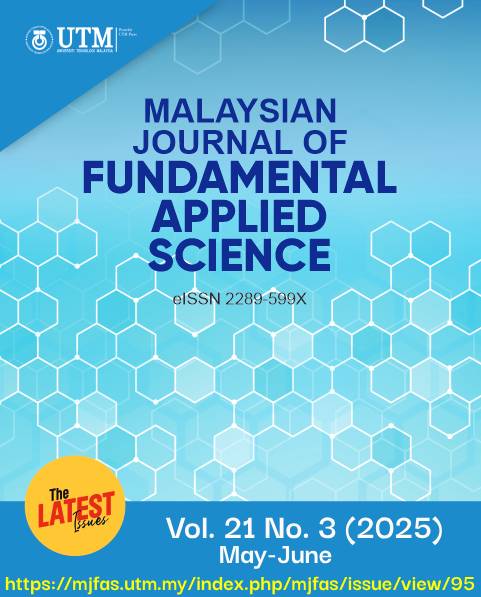Enhancing Average Run Length Efficiency of the Exponentially Weighted Moving Average Control Chart under the SAR(1)L Model with Quadratic Trend
DOI:
https://doi.org/10.11113/mjfas.v21n3.4290Keywords:
Average run length, explicit formulas, numerical integral equation, Banach's fixed-point theorem.Abstract
This study proposes an explicit formula for finding the Average Run Length (ARL) of Exponentially Weighted Moving Average (EWMA) control charts when applied to seasonal autoregressive processes with a quadratic trend. The ARL values derived from the proposed explicit formula were evaluated for accuracy by comparing them with results from the numerical integral equation (NIE) approach utilizing the Midpoint rule. These methods were assessed using real-world applications in the medical field, along with comprehensive simulations. The results demonstrate that the proposed explicit formula and the NIE method closely align in terms of accuracy, with the explicit formula significantly enhancing computational efficiency compared to the NIE method. These findings suggest that the explicit formula is an effective tool for enhancing control chart performance across multiple disciplines.
References
Shewhart, W. A. (1931). Economic control of quality of manufactured product. Van Nostrand.
Page, E. S. (1954). Continuous inspection schemes. Biometrika, 41, 100–114.
Roberts, S. W. (1959). Control chart tests based on geometric moving average. Technometrics, 1, 239–250.
Crowder, S. V. (1987). A simple method for studying run length distributions of exponentially weighted moving average charts. Technometrics, 29, 401–407.
Lucas, J. M., & Saccucci, M. S. (1990). Exponentially weighted moving average control schemes: Properties and enhancements. Technometrics, 32, 1–29.
Areepong, Y., & Novikov, A. A. (2009). An integral equation approach for analysis of control charts [PhD thesis]. University of Technology, Australia.
Mititelu, G., Areepong, Y., Sukparungsee, S., & Novikov, A. A. (2010). Explicit analytical solutions for the average run length of CUSUM and EWMA charts. East-West Journal of Mathematics, 1, 253–265.
Vanbrackle, L. N., & Reynolds, M. R. (1997). EWMA and CUSUM control charts in the presence of correlation. Communications in Statistics - Simulation and Computation, 26(3), 979–1008.
Busaba, J., Sukparungsee, S., Areepong, Y., & Mititelu, G. (2012, March 7–10). Numerical approximations of average run length for AR(1) on exponential CUSUM. Proceedings of the International Multi-Conference of Engineers and Computer Scientists, Hong Kong.
Petcharat, K., Areepong, Y., & Sukparungsee, S. (2013). Explicit formulas of average run length of EWMA chart for MA(q). Far East Journal of Mathematical Sciences, 78, 291–300.
Sunthornwat, R., Areepong, Y., & Sukparungsee, S. (2018). Average run length with a practical investigation of estimating parameters of the EWMA control chart on the long memory AFRIMA process. Thailand Statistician, 16(2), 190–202.
Phanyaem, S. (2022). Explicit formulas and numerical integral equation of ARL for SARX(P,r)L model based on CUSUM chart. Thailand Statistician, 10(1), 88–99.
Petcharat, K. (2022). The effectiveness of CUSUM control chart for trend stationary seasonal autocorrelated data. Thailand Statistician, 20(2), 475–488.
Peerajit, W. (2023). Statistical design of a one-sided CUSUM control chart to detect a mean shift in a FIMAX model with underlying exponential white noise. Thailand Statistician, 21(2), 397–420.
Sunthornwat, R., Areepong, Y., & Sukparungsee, S. (2024). Evaluating the performance of modified EWMA control schemes for serially correlated observations. Thailand Statistician, 22(3), 657–673.
Champ, C. W., & Rigdon, S. E. (1991). A comparison of the Markov chain and the integral equation approaches for evaluating the run length distribution of quality control charts. Communications in Statistics - Simulation and Computation, 20, 191–204.
Downloads
Published
Issue
Section
License
Copyright (c) 2025 Dollaporn Polyeam, Suvimol Phanyeam

This work is licensed under a Creative Commons Attribution-NonCommercial 4.0 International License.




















